Rapid assessment of the impact of COVID-19 lockdown on farmers in Khordha District helped in identifying the nature and extent of losses faced by farmers in different crop and enterprises. Krishi Vigyan Kendras (KVKs) and ICAR institutes conducting this type of quick analysis will help every organisation in identifying strategies to support farmers in each district during the lockdown, and also in refining their plans for the next season, Dr P N Ananth and Dr B R Pillai argue in this blog.
CONTEXT
That Odisha has shown how to live up to the challenge of frequent disasters that visit the state in the form of cyclones, floods, dry spells, erratic rainfalls, delayed monsoons and many others. The people of Odisha and the government have been highly accustomed (in comparison to any other state of India) to face and cope with climate extremes. The year 2019 was a bad start for Odisha with the cyclone Fani that hit the state on 3 May, 2019, making life miserable for the people, especially farmers in 14 districts of the state. It took four months to return to normalcy. But within less than a year, in February 2020, COVID-19 began to spread in the state.
The first positive case of COVID-19 was reported in the state on 16 March, 2020. To contain the pandemic, the state also observed and joined the first “Janata curfew” declared by the central government on 22 March, 2020. Since 25 March, like other parts of India, Odisha has been under strict lockdown. On observing increasing number of positive cases, the government declared a 48-hour shutdown in Odisha, mainly in Khordha and Cuttack districts, on 3 April, 2020. The Government of Odisha was the first state to publicly announce extension of the lockdown from 14 April to 30 April. However, like other states in the country Odisha gave relaxations to certain activities especially in agriculture, dairy and fisheries during the lockdown. Though these relaxations exist, many small and marginal farmers are not able to undertake farm management practices or market their produce.
In this context, to understand the impact of COVID-19 on agriculture and allied sectors, a Rapid Appraisal study was undertaken by KVK-Khordha (the farm science centre) under ICAR-Central Institute for Freshwater Aquaculture (CIFA), Bhubaneswar, Odisha, during 6-11 April. This blog is based on the information collected from 50 small and marginal farmers who are active in farming from the adopted villages of KVK.
RAPID APPRAISAL STUDY
The study was undertaken by KVK for assessing the impact of both lockdown and two shutdown periods due to COVID-19 in Khordha district of Odisha. Khordha is one of the 30 districts of the state with abundant natural resources to support livelihood of rural and urban population. Agriculture and allied sectors like animal husbandry (dairy and poultry) and fisheries (aquaculture) play a vital role in the economic development of the district. A telephonic survey was conducted with 50 farmers representing all the 10 blocks of Khordha district with a set objective. The 50 farmers selected for the study have a good profile in agriculture and allied sectors, and had standing crops ready to harvest during this period.
FINDINGS
Status of agriculture during this period
It is a general practice by farmers in the district to cultivate pulses, oil seeds and vegetables after harvest of paddy. During this period, few farmers cultivate paddy (areas with assured irrigation). In the district, during Kharif season 1,07,788 ha is allocated for paddy cultivation followed by a meagre area of 2,835 ha during rabi season. Hence, the area under paddy during the lockdown period was negligible. In addition, farmers of few blocks cultivate oil seeds. That apart, vegetables and fruits are also cultivated. During lockdown and shutdown periods, there were standing crops in large area under pulses, oil seeds, vegetables and fruits. Animal resources including milk, chicken, goat and sheep were also available without being affected significantly during the period. Fish from freshwater resources were also being harvested on a daily basis. Hence, it can be concluded that standing crops, milk, meat and fish were all available during the lockdown period.
The representation in the bar chart above indicates the area under crops to be harvested during the lockdown and shutdown period. The constraints faced by farmers during this period in different sectors are discussed below.
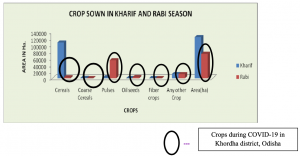 Challenges faced by farmers
Challenges faced by farmers
Field crops, vegetables and fruits
- Management practices like weed eradication, control of insects and pests were not performed due to non-availability of inputs and in turn, this affected the yield of paddy with a reduction of 0.5t/ha. All input shops were closed, which hindered farmers to adopt proper management practices. It was observed that in certain places shops were open only for a limited period. Few farmers suffered as they have not completed threshing of the paddy harvested during the Kharif season due to scarcity of labour.
- Due to unavailability of labour, many farmers were not able to harvest green gram, black gram and sunflower, which incurred losses to them. Though labour was available, it was prohibitively expensive (Rs.300/men/day and Rs 200/women/day). Farmers were not able to transport harvested products to nearby and distant markets.
- Farmers are hampered in collection of good variety paddy seeds for the coming Kharif season from society or seed growers due to lack of transportation facilities. This is expected to have an impact during the season.
- Farmers in some areas rued the lack of regular irrigation from the Lift Irrigation (LI) points. The farmers informed that it was due to the continuous absence of staff from the electricity board. The same was true with certain farmers who depend on LI points for irrigating crops.
- Few farmers who depend on wholesale markets for selling vegetables faced difficulties. For instance, in Chandapur Village of Chilika Block, farmers were depending on the wholesale market at Nayagarh district. During the lockdown period, the market has been functional during 2 am – 6 am only. The farmers faced difficulty to approach and dispose their produce.
- While few farmers tried to sell vegetables in nearby villages, neighbouring villagers blocked approach roads fearing spread of the virus from outsiders.
- Considering these constraints in marketing the produce, many farmers hesitated to harvest the produce and allowed it to get wasted. Even high-value crops like capsicum were left unplucked.
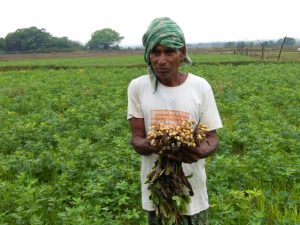 A good harvest of groundnut waiting for buyers
A good harvest of groundnut waiting for buyersDairy, poultry and fish
- Though cattle feed was available in the market, many farmers did not purchase it as there was no market for milk and milk products. Even milk cooperative societies and the gualas are reluctant to collect milk from the framers as it was done earlier. So, farmers are distributing milk to neighbours, converting to paneer, chenna etc. for home consumption and throwing away surplus milk.
- Commercial poultry farming, especially broiler farming, is seriously affected due to non-availability of chicks (day-old), feed and marketing of adult birds. Even the companies under contractual farming system are not in a position to support their farmers under contract. Grown birds are being sold/distributed at very low prices and the farms are lying idle. Few farmers are bound to cull the matured birds due to lack of marketing.
- The situation of goat and sheep is in a somewhat better situation due to open grazing/browsing system of farming in the locality. However, sale of the marketable livestock has reduced due to less consumption of meat by consumers in view of COVID-19 fears.
- Critical inputs like fish feed, medicines and drugs were not available that affected farmers to adopt management practices for sustained growth of fish.
- Farms dependent on external labour suffered to perform pond and feed management activities including harvesting fish from large ponds.
- As transportation was halted, fish were not sold in distant markets. The catch was also not being sold in usual disposal ways (few farmers used to sell live fish which has better profits).
- Majority of the farmers perceived that fish were sold at low price. Few farmers informed that procurement of fish seeds of Indian Major Carps (catla, rohu and mrigal) are available. The fish farmers felt they can procure even after the lockdown is lifted. However, certain farmers procure non IMC seeds from West Bengal, which has been constrained due to the halt in transportation facilities.
- There were fewer buyers of fish seeds. Many of the hatchery owners explained that managing the brood stock has to be done professionally. To maintain them, labour was found to be short and unavailable during this period.
- Preparatory activities for the forthcoming breeding season were affected due to shortage of labour. However, certain hatchery owners said family labour was fully involved to meet the demand.
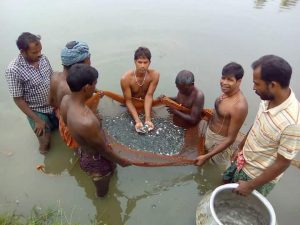 Disruptions in fish seed supply chain caused heavy losses to fish farmers
Disruptions in fish seed supply chain caused heavy losses to fish farmers
Quantification of losses due to COVID-19
The above survey has made it evident that there has been loss to agriculture and allied sectors due to lockdowns and shutdowns following COVID-19 pandemic due to four reasons (Fig-1). It can be concluded that the losses have resulted from non-adoption of management practices for the standing crops due to inadequate input supply of fertilizers and agro chemicals. The next constraint that caused losses was shortage of labour on the farm. Above all, the shutdown of markets and low price has been the prime reasons for the farmers to incur losses.
Extent of loss at farm level
The extent of loss at the farm level has to be calculated for providing an impact figure of the lowdown due to COVID-19 pandemic. From the survey, loss was estimated taking into different type of crops and farming systems (Table 1)
Table 1: Loss incurred in different enterprises due to COVID-19
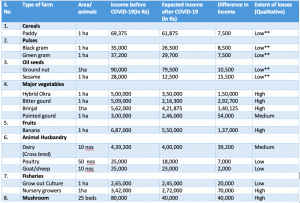
*Rabi paddy, ** May be switched to medium and high loss if not sold at right time within 30-40 days as quality may deteriorate
Source: Compilation from the present survey
It is evident that perishable products (vegetables, fruits and dairy) have been affected more than other farm produce. The loss has been highest for brinjal, okra, pointed gourd, bitter gourd followed by fruits like banana. However, in the case of cereals it has been observed that the loss in terms of income may be less as they are not perishable. The harvested cereals and pulses like rice, green gram, black gram, green gram, ground nut and sesame did not result in much loss in terms of income as they are not perishable and can be stored and sold later. Farmers perceive these products can be sold on a larger scale but quality and the time of the sale matters. However, there may be losses later as the quality of product may deteriorate. In the case of sesame, the crop is not much of a commercial type, hence the price may still be low while farmers try to sell in market. In the case of vegetables, it has been observed that there will be an income loss of 40-45% on bitter gourd followed by 30% in hybrid okra, 25% in brinjal, 15-18% in pointed gourd and 20% in the case of fruits like banana.
Milk is one of the most affected products in the animal husbandry sector with a loss of Rs. 39,200 with 10 dairy cows, followed by Rs.7,000 in poultry. In the case of goats and sheep, farmers are in safe hands as they can sell the products after lockdown. Farmers fatten goats and sheep by allowing them to graze rather depending on commercial feed. Hence, the feed requirement was less in goats and sheep though feed was not available with input dealers.
One of the sectors assumed to have been much affected is aquaculture as the breeding season is set to start by June-July, 2020. However, fish seed production depends on hatchery operations and few preparatory activities on brood stock management have been halted due to shortage of labour. Hatchery owners who depend on family labours for operation would have been in safe hands. In the case of grow-out fish farmers, harvested fish has fetched low price but they can plan to sell fish after the lockdown is lifted. In the case of nursery growers, there were few buyers of seeds. Compared to other field crops, vegetables, fruits, dairy, poultry and related cropping systems, aquaculture has not been much affected in the case of small scale fish farmers.
High hopes on a successful South West Monsoon during Post COVID session
Now, all eyes are on the South-West Monsoon. A successful monsoon can influence the recouping of losses incurred with ease and relief.

Leading met agencies, including IMD, agree that the El Nino and DMI (Dipole Mode Index) are quite favourable for the monsoon onset over India. Summer in Odisha will not be a blistering one this year (Excerpt from Odishatv.in).
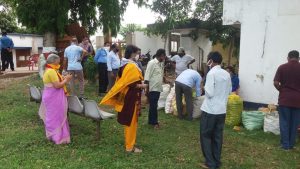 KVK-CIFA opened its campus for farmers to sell their produce directly to consumers
KVK-CIFA opened its campus for farmers to sell their produce directly to consumers
PLANS ENVISAGED BY ICAR-CIFA AND KVK FOR SUPPORTING FARMERS POST COVID-19
Though organisations like KVK and ICAR-CIFA have their mandates, there are certain situations like climate extremes and pandemics like COVID where they can respond by providing additional relevant services. In this regard, an action plan has been envisaged by ICAR-CIFA and KVK to serve the farmers by providing extension and advisory services. KVKs act as a semi–extension agency, playing a key role in providing advisory services using information and communication tools, personal home and farm visits and through other ways (Ananth et al., 2018). KVKs being semi-extension agencies, their role and performance may not be on a larger scale to satisfy large producers in the whole district. Within set mandates, KVKs have a role to play in production of few critical inputs that are not largely available in the market. Hence, in these situations KVK can work on production of such valuable critical inputs to support the farmers. For an example, the KVKs of Andaman and Nicobar, West Bengal and Odisha under ATARI, Zone V, during 2018-19 produced 17921.04 q seeds, 51,13,450 planting materials, 1,49,447.62 kg bio-agents, 4,24,1662 livestock and fishery products (ATARI, 2019). Within the limits and capability of ICAR-CIFA and KVK, an action plan has been worked out for pre and post lockdown periods to support farmers (Table 2).
Table 2: Proposed action plan ICAR-CIFA and KVK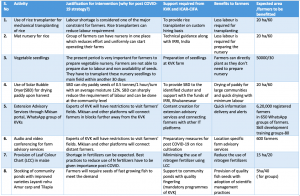
CONCLUSION
With the above information, KVKs will have to keep informed other organisations at the district level to support farmers with relevant interventions. That apart, KVK has discussed with other organisations like ATMA, Department of Agriculture, Coconut Development Board, Reliance Foundation and National Fisheries Development Board to support each other in their relief works. A few workable activities of KVK to support farmers during and post-COVID-19 will be:
During lockdown
- Providing physical resources like space of KVK to market farm produce of farmers from villages adopted by KVK
- Working with IT partners to disseminate information on COVID prevention measures and audio and video conferencing to provide extension advisory services
- Preparation of planting materials for farmers (specially vegetables), providing other inputs like seeds, bio-fertilizers, base materials for enterprises and other possible specialised inputs.
Post lockdown
- Provision of planting materials, seeds, chicks, fish seeds of improved varieties and others (prepared during the lockdown period by the KVK)
- Leasing out farm machineries and implements to certain clusters to reduce labour and its associated cost
- Disseminating best practices for efficient farming (by reducing external inputs)
- Providing space to SHGs to work on value addition and processing with available equipment
- Demonstration of activities in cluster mode rather than individually
- Again, no doubt convergence with similar organisations will prove effective delivery of the intended relief measures.
Preparation to support farmers post COVID-19 to face Kharif season will be crucial. Sufficient planting materials, quality inputs and advisory services can change the situation. In the case of Odisha, these situations happen twice a year.
References
Ananth, P. N.; Sahoo, P. R.; Babu, Suresh Chandra; Barik, N. K.; and Sundaray, J. K. 2018. Scaling up innovations through adaptive research: An institutional analysis and lessons from farm science centers in India. IFPRI Discussion Paper 1711. Washington, D.C.: International Food Policy Research Institute (IFPRI). http://ebrary.ifpri.org/cdm/singleitem/collection/p15738coll2/id/132314
ATARI, 2019. Annual Report 2018-19 of Agricultural Technology Application Research Institute, Kolkatta: 170 pp
Saju, G., Prabhakar, B and K.P. Subbaiah.2020 -KVK Kodagu and Puthari FPO coming to the aid of farmers during the lockdown, Field Notes 2, AESA,: 4pp

Dr. P. N. Ananth is Senior Scientist and Head, KVK-Khordha, ICAR-Central Institute for Freshwater Aquaculture, Bhubaneswar, Odisha (Email: ananthkvk100@gmail.com)

Dr. B. R. Pillai is Director, ICAR-Central Institute for Freshwater Aquaculture, Bhubaneswar, Odisha (Email: bindupillaicifa@gmail.com)

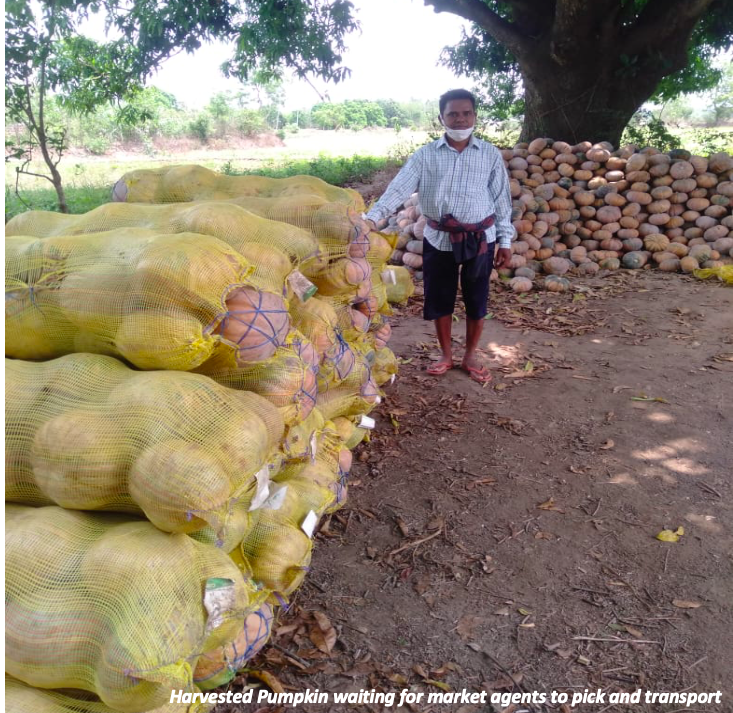

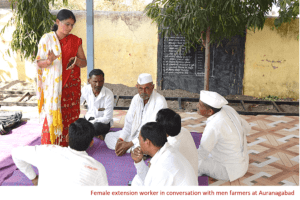
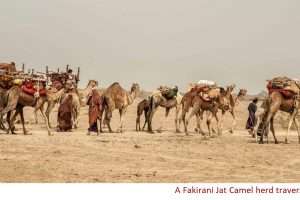
Congratulations to Drs. Ananth and Pillai on coming out with a very good analysis on impact of COVID19 on farmers during lockdown period. If all the KVKs in India adopt a similar methodology to assess the impact, the findings will help to evolve appropriate long term strategies to reduce the negative impact on farmers. It is comparatively easy to assess the short term impact than long term impacts. It is clear from this study also that those farmers who depend upon external inputs for production are the ones who incurred heavy losses. suffer more. Similarly, the vegetable and fruit growers also suffered because the products are perishable. Although, there is not much that could be done to save the farmers during this season, we need to think about protecting them in the coming season through appropriate interventions which must be location specific.